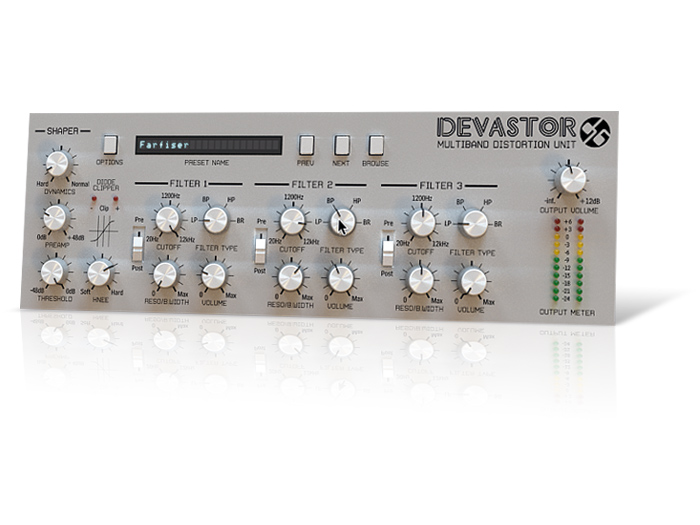MusicRadar Verdict
Devastor is a killer distortion plug-in, and much more exciting to use than it might seem on paper. At this price, what's stopping you?
Pros
- +
Excellent sound. Good, well categorised presets. Three-way filtering. Flexible signal path. Great value for money.
Cons
- -
No per-filter clipping!
MusicRadar's got your back
Culled from (and improving upon) the distortion used in the company's TB-303 emulation, Phoscyon, Devastor is a cross-platform VST and AU effect plug-in that's capable of producing a vast range of distortion effects, from subtle clipping to ear-shredding assault.
Based on the sound that's produced by diode-clipping circuits, Devastor is a lot more than a simple fuzzbox. The distortion section is powerful in its own right, but it's only one part of a bigger whole. Devastor comprises a dynamics processor along with the clipper section itself, and wraps the lot in a trio of resonant multimode filters.
In detail
The dynamics section is serviced by a single knob that swings between Hard and Normal settings. Simple though this is, it does the job, keeping levels in check so they can be further processed, and it can really get drum beats slamming.
Next up is the diode clipper, which triples the knob count with its Preamp, Threshold and Knee controls. The Threshold determines the amplitude level above which the distortion should kick in. The Knee governs the character of the distortion - that is, whether it's a soft- or hard-clipping type.
Devastor's tone-shaping tools are not based upon EQ circuits, as some distortions are. Rather, they emulate analogue filters. There are three of them, each a multimode affair with resonance and cutoff controls. Low-pass, high-pass, band-pass and band-reject varieties are all provided, and a Pre/Post switch determines the position of each filter in the signal path.
This is a flexible arrangement and enables you to create unique sounds. The only criticism we can level here is that, despite Devastor being branded a multiband distortion, there's but a single clipping stage - a switch to enable a clipping stage for each filter could really be something!
Want all the hottest music and gear news, reviews, deals, features and more, direct to your inbox? Sign up here.
Summary
We're telling it like it is when we say that Devastor sounds devilishly divine, if that isn't a contradiction in terms. It sounds (and looks) awesome just sitting there, but it really shines when you add a bit of MIDI control to the proceedings - MIDI learn is onboard, of course.
Not only that, but there's also a healthy selection of presets included, covering most common uses, from trashing drums to sweetening electric pianos. Needless to say, we tried them all on a wide variety of sources, and they never let us down. The distortion can scream, but doesn't exhibit some of the unpleasantly harsh qualities we've heard with many other clippers.
Sure enough, d16 has a winner on its hands, and at a mere €29, there's little reason not to snap it up.
Take a listen to what Devastor can do:
MusicRadar is the number 1 website for music makers of all kinds, be they guitarists, drummers, keyboard players, djs or producers...
GEAR: We help musicians find the best gear with top-ranking gear round-ups and high- quality, authoritative reviews by a wide team of highly experienced experts.
TIPS: We also provide tuition, from bite-sized tips to advanced work-outs and guidance from recognised musicians and stars.
STARS: We talk to musicians and stars about their creative processes, and the nuts and bolts of their gear and technique. We give fans an insight into the actual craft of music making that no other music website can.

